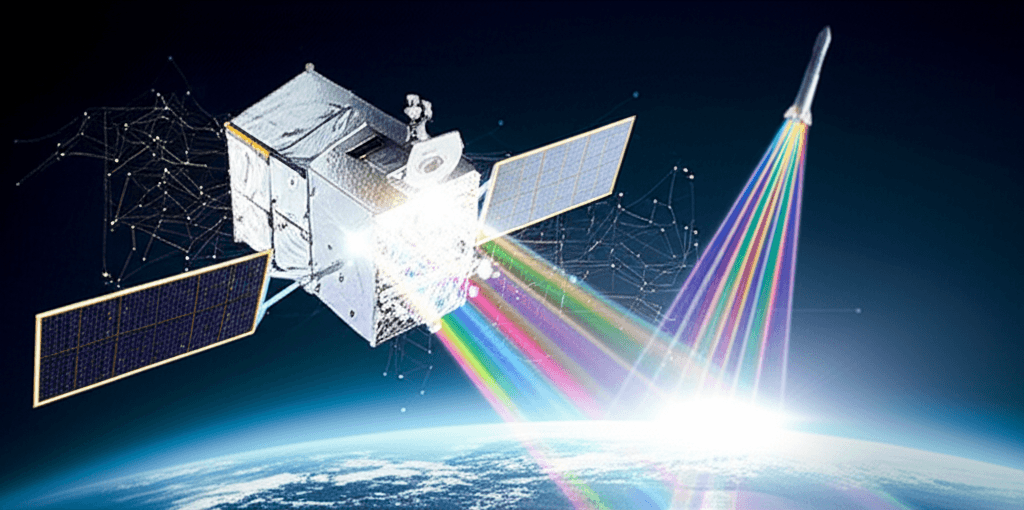Dhruva Space Launches First Commercial Mission with On-Orbit AI
Marking a global leap, Dhruva Space's commercial mission launches indigenous AI and hyperspectral payloads for real-time Earth insights.
August 5, 2025

Hyderabad-based space-tech startup Dhruva Space is set to launch its first commercial mission, LEAP-1, aboard a SpaceX Falcon 9 rocket in the third quarter of 2025.[1][2][3][4] This marks a significant milestone for the company, transitioning from successful technology demonstrations to customer-driven satellite deployments.[5][4] The mission will carry payloads for two Australian companies, Akula Tech and Esper Satellites, showcasing a notable Indo-Australian collaboration with growing support from the United States.[1][5][2] This venture follows the successful in-orbit qualification of Dhruva Space's P-30 satellite bus on the Indian Space Research Organisation's (ISRO) PSLV-C58 POEM-3 mission in January 2024.[1][5][3][6] The LEAP-1 mission is a testament to the burgeoning private space sector in India and its increasing global integration.
The core of the LEAP-1 mission is Dhruva Space's indigenously developed P-30 satellite platform, a versatile nanosatellite bus designed for missions in Low Earth Orbit (LEO).[7][8] This modular and payload-agnostic platform is scalable for earth observation constellations and can accommodate multiple payloads.[5][7][8] The P-30 was space-qualified during the LEAP-TD (Technology Demonstrator) mission on ISRO's PSLV-C58 POEM-3.[5][9][10] The POEM-3 platform itself is a unique and cost-effective initiative by ISRO, utilizing the spent fourth stage of the PSLV rocket as an orbital experimental module.[11][12] For the LEAP-1 mission, the P-30 bus will host two distinct and advanced payloads from its Australian clients.[5][4][13][14] Akula Tech's payload, Nexus-01, features an advanced Artificial Intelligence (AI) module for onboard data processing and real-time geospatial analytics.[1][5][9] Esper Satellites' payload, OTR-2, consists of a hyperspectral imager designed to capture detailed Earth observation data.[1][5][4] This fusion of technologies on a single platform highlights the adaptability of Dhruva Space's satellite bus.[5]
The payloads on the LEAP-1 mission have significant implications for the AI and Earth observation industries. Akula Tech's Nexus-01 AI module is designed to perform on-orbit data processing and can even retrain machine learning models using data generated by the satellite.[5][2] This capability for onboard AI processing offers a significant speed advantage for time-sensitive missions, enabling near real-time insights for applications such as defense, disaster response, and environmental monitoring.[5][3][9] The ability to retrain AI models in orbit using live sensor data allows for continuous improvement and adaptation of applications like fire detection and spectral analysis.[9] Esper Satellites' OTR-2 hyperspectral imager will provide spectrally-rich remote sensing data, which can be used for a wide range of applications including agriculture, mining, and environmental management.[1][5][2][4] The data will be accessible through Esper's EarthTones API, setting a new standard in remote sensing technology.[5][9] The combination of these two payloads on the LEAP-1 mission will create a powerful tool for a variety of sectors that rely on timely and detailed geospatial information.
The LEAP-1 mission is a clear indicator of the growing maturity and global ambition of the Indian space-tech startup ecosystem. Founded in 2012, Dhruva Space has steadily built its capabilities, providing full-stack space engineering solutions.[1][15] The company has successfully raised significant funding, with its Series A round closing at INR 123 Crores ($15 million).[1][16] This financial backing has enabled Dhruva Space to develop its satellite platforms and expand its offerings.[16] The Indian government's push to open up the space sector to private enterprises, through initiatives like the establishment of the Indian National Space Promotion and Authorization Centre (IN-SPACe), has been instrumental in the growth of companies like Dhruva Space.[15][17][18] IN-SPACe has authorized Dhruva Space to provide Ground Station-as-a-Service (GSaaS), which will be integrated with its proprietary Integrated Space Operations & Command Suite (ISOCS) to support the LEAP-1 mission with real-time management and data downlinking.[5][2][19] This mission, a collaboration between Indian, Australian, and American entities, symbolizes India's emergence as a key player in the global space economy.[5][2]
In conclusion, Dhruva Space's LEAP-1 mission represents a significant leap forward for the company and the Indian private space industry as a whole. The launch, scheduled for the third quarter of 2025 on a SpaceX Falcon 9, will be the company's first commercial deployment, building on the successful qualification of its P-30 satellite platform.[1][3][4] By carrying advanced AI and hyperspectral imaging payloads for Australian customers, the mission not only showcases the technical capabilities of Dhruva Space but also the potential for international collaboration.[1][5][2] The implications for the AI and Earth observation sectors are substantial, with the promise of real-time, in-orbit data processing and analysis.[5][3][9] As India continues to foster its private space ecosystem, missions like LEAP-1 will be crucial in demonstrating the country's growing capabilities and competitiveness on the global stage.
Sources
[1]
[4]
[5]
[7]
[10]
[11]
[12]
[15]
[16]
[17]
[19]